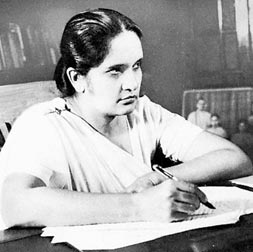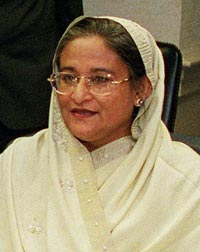Low on the leadership ladder
Study finds women are held back from top academic
careers in South Asia:
by Louise Morley and Barbara Crossouard
While women are increasingly entering the global academy as
undergraduate students, they are having less success in securing
leadership roles in higher education. This is a recurring problem in
countries such as the UK, but it is even more pronounced in regions such
as South Asia. Only 3% of the people in vice-chancellor level positions
in India are women and Nepal does not have any.
 |
 |
|
While there have been female heads of
state in the region – Sheikh Hasina is the current Prime
Minister of Bangladesh and Sirimavo Bandaranaike, in Sri
Lanka was the first female Prime Minister in the world in
1960 – women are largely still identified with the domestic
sphere. Pix courtesy www.britannica.com and
commons.wikimedia.org |
As part of a recent study for the British Council, we interviewed 23
(male and female) academics from Afghanistan, Bangladesh, India,
Pakistan and Sri Lanka - where 21.4% of university vice-chancellors are
women - on what they saw as the barriers to getting more women into
leadership positions in universities.
While there have been female heads of state in the region - Sheikh
Hasina is the current Prime Minister of Bangladesh and Sirimavo
Bandaranaike, in Sri Lanka was the first female Prime mMinister in the
world in 1960 - women are largely still identified with the domestic
sphere. There are potent cultural messages about what constitutes
gender-appropriate behaviour, with leadership and authority related to
hegemonic masculine roles.
Away from the limelight
There is also a cultural belief among some that women should not have
seniority or authority over men. Women in leadership positions are seen
to disrupt the symbolic order and traditional power relations. In some
instances has been related to particular cultural understandings of
Islamic religion.
Many women, in South Asia and elsewhere, can also be uncomfortable
with seniority, or having to prove their worth to unsympathetic, and
often-hostile critics. The vulnerability of leaders to allegations of
bribery and corruption were also mentioned by several of the people we
interviewed. This negative visibility was thought to deter many women
from seeking high-profile roles.
Gender-based violence - both actual and symbolic - is also a major
concern in the region. Not only does this damage women's health and
well-being, but it also jars with the assertive behaviours required for
leadership. For example, one Indian respondent told us that the system
of arranged marriages turns women into passive objects to be evaluated,
rejected or accepted. They are chosen, not choosers.
Class and recruitment
Social class and caste intersected with gender to determine which
women could enter leadership positions. Women from more privileged
socio-economic backgrounds often reported family support and cultural
capital that helped them navigate education and employment
opportunities. Opportunities for leadership in higher education were
highly uneven across the region, and most often associated with urban
elite families.
The appointment of leaders can often be a political process,
explicitly or implicitly, requiring lobbying and the construction of
highly visible public profiles. This often works against women who can
be excluded from influential networks and coalitions because of codes of
sexual propriety.
|

Women are kept low on the leadership ladder. Pic by Rajiv
Ashrafi, CC BY-NC-SA |
There is also a lack of programmes in South Asia to develop women's
leadership. Successful senior women discussed how they had had to learn
on the job, or seek out their own development - often overseas.
Power relation
There were no formal mentoring arrangements, very few development
programmes (apart from the Association of Commonwealth Universities
Gender Programme) and no structured capacity-building or career advice.
There have been some moves to change this, including locally-driven
projects such as the Centre for Gender Studies at Sri Lanka's University
of Kelaniya. However, many initiatives have come from the global North,
such as the IKEA Foundation's scholarships for the Asian University for
Women in Bangladesh. While this can represent an important
redistribution of resources, some of the academics we interviewed
expressed concerns about interventions requiring a buy-in to Western
values and power relations.
Although some higher education policies in South Asia, such as recent
laws in Afghanistan, Bangladesh and India, suggest an awareness of
gender issues overall, there has been an absence of specific policy
texts on gender equality. Gender was sometimes mentioned in relation to
the need to increase the participation of women students. But the
absence of statistics on the gender of staff meant that progress was not
being monitored or managed.
Universities in South Asia aspire to enter the top 100 in global
league tables. Yet gender equality is not seen as an indicator of
quality. But equality is quality, and that investment in women in the
global knowledge economy will yield rich returns.
(Louise Morley is Professor of Education at
University of Sussex and Barbara Crossouard is Senior Lecturer in
Education at University of Sussex. This article was originally featured
in The Conversation) |

